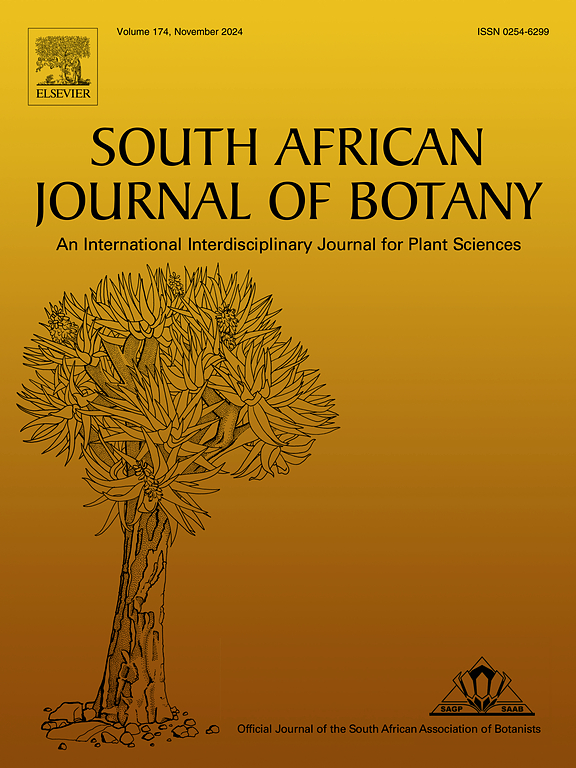非洲南部用于艾滋病毒管理的民族植物综述
IF 2.7
3区 生物学
Q2 PLANT SCIENCES
引用次数: 0
摘要
背景艾滋病毒感染是影响南部非洲国家的主要健康问题之一。南部非洲国家通过抗逆转录病毒药物(ARVs)和具有抗艾滋病毒特性的人种植物来控制艾滋病毒感染。由于艾滋病病毒对目前的抗逆转录病毒药物产生了抗药性,因此有必要寻找具有抗艾滋病毒特性的新型化合物。南部非洲拥有丰富的生物多样性以及经证实具有抗病毒、抗细菌和抗真菌特性的植物化学物质,因此拥有一个良好的新型化合物宝库,可将其开发为高活性抗逆转录病毒疗法(HAART)。研究目的本综述旨在调查报道传统医者使用民族植物治疗艾滋病病毒感染和艾滋病病毒引起的机会性感染的文献:(a) 未进行活性植物化学物质筛选的文献;(b) 结合使用粗提取物进行筛选的文献;以及 (c) 筛选和鉴定活性植物化学物质的文献。本综述中使用的文章在 Science Direct、Springer Link、PubMed Central 和 Google Scholar 中进行了搜索。论文分为三类:传统医学家使用或鉴定的植物,未进行活性植物化学成分筛选;使用粗提取物进行活性植物化学成分筛选;纯化并筛选。其他已确定和注明的参数包括细胞类型、抗 HIV 试验和毒性试验,这些试验用于模拟 HIV 感染和抑制,以及文章中确定的其他病毒、细菌和真菌感染。结果在 2018 年至 2024 年期间,共有 22 篇出版物和 6264 种人种植物被报道用于治疗南部非洲的 HIV 感染和 HIV 合并感染。这些数字高于 2007 年至 2018 年期间报告的数字(19 篇出版物和共计 1664 种人种植物)。大多数出版物都是调查研究,报告了使用人种植物治疗艾滋病毒感染和合并感染的情况,但未对活性代谢物进行筛选和鉴定,其次是调查研究,同时使用粗提取物对活性代谢物进行筛选。只有极少数研究超越了调查研究,使用粗提取物检测是否存在具有抗艾滋病毒特性的植物化学物质。在2018年至2024年期间,仅有一篇出版物报道了分离和纯化活性代谢物以获得抗HIV特性,而在2007年至2018年期间仅有五项研究。研究发现,Croton. dichogamus 植物的粗提取物的 IC50 最低,为 0.06 ± 0.01 μg/mL。在 Peltophorum afrianum 植物中发现纯化合物的 IC50 为 0.002 μg/ml。文献综述表明存在重复劳动和错失良机的现象。多篇文献采用相同的方法和检测手段对同一种植物的抗艾滋病毒特性进行了筛选。大多数出版物仅筛选了对 HIV 的抑制作用,而伴随出版物的调查研究则确定了植物对 HIV、真菌和细菌感染的用途。常用的细胞类型、HIV 检测方法和毒性检测方法包括 MT-4 细胞、MTT 检测方法和 HIV-1 逆转录酶(RT)。这些植物所含的植物化学物质可干扰 HIV 对宿主细胞的感染和复制周期,因此是新型分子的潜在来源,可被制成强效的 HIV 药物。需要做出更多努力,将报告人种植物使用情况的调查研究与确定活性植物化学物质的筛选研究结合起来,以确定传统治疗师使用的植物确实具有 "宣传 "的特性。本文章由计算机程序翻译,如有差异,请以英文原文为准。
A review of ethnobotanical plants that are used for HIV management in Southern Africa
Background
HIV infections are one of the major health issues affecting southern African countries. HIV infections in southern African countries are managed by antiretroviral medications (ARVs) and ethnobotanical plants with anti-HIV properties. The development of HIV viral resistance to current ARVs necessitates the search for new and novel compounds with anti-HIV properties. Southern Africa is rich in biodiversity and phytochemicals with proven anti-viral, bacterial, and fungal properties, and therefore has a good reservoir of novel compounds that can be developed into highly active antiretroviral therapy, or HAART.
Aim of the study
The review aims to survey the literature that reported the use of ethnobotanical plants by traditional healers to treat HIV infections and opportunistic infections caused by HIV (a) without screening for active phytochemicals and (b) coupled with screening using crude extracts, and (c) screening and identification of active phytochemicals.
Materials and methods
Peer-reviewed, original research, and review publications published from 2007 to 2024 were considered in this review. Articles used in this review were searched in Science Direct, Springer Link, PubMed Central, and Google Scholar. Papers were categorized into three groups: plants used or identified by traditional healers and not screened for active phytochemicals; active phytochemicals were screened for active phytochemicals using crude extract; and purified and screened. Other parameters that were identified and noted were the cell types, anti-HIV assays, and toxicity assays that were used to model HIV infection and inhibition, as well as other viral, bacterial, and fungal infections identified in the articles.
Results
Between the years 2018 and 2024, a total of 22 publications and 6264 ethnobotanical plants were reported to be used for treating HIV infections and HIV co-infections in Southern Africa. These numbers are higher than the numbers reported between the years 2007 and 2018 which were 19 publications and a total of 1664 ethnobotanical plants. Most of the publications were survey studies that reported the use of ethnobotanical plants for the management of HIV infections and co-infections without screening and identification of active metabolites followed by survey studies that were coupled with screening of active metabolites using crude extracts. Very few studies went beyond survey studies and used the crude extract to test for the presence of phytochemicals with anti-HIV properties. Only one publication was found that reported the isolation and purification of active metabolite for anti-HIV properties in the year between 2018 and 2024 and only five studies in the years 2007 and 2018. Crude extracts of Croton. dichogamus plant was found to have the lowest IC50 of 0.06 ± 0.01 μg/mL. IC50 of the pure compound was found in the Peltophorum afrianum plant with IC50 of 0.002 μg/ml. The literature review suggests a duplication of efforts and missed opportunities. Multiple publications screened the same plants for anti-HIV properties using identical methodologies and assays. Most of the publications screened for only HIV inhibition while survey studies accompanied the publications identified the use of plants for HIV, fungal, and bacterial infections. Commonly used cell type, HIV assays, and toxicity assays that were used to model HIV infection, progression, and inhibition of phytochemicals were found to be MT-4 cells, MTT assays, and HIV-1 reverse transcriptase enzyme (RT).
Conclusion
Southern Africa has diverse plant species with medicinal properties. These plants contain phytochemicals that interfere with HIV infection to host cells and replication cycles and therefore a potential source of novel molecules that can be potent into potent HIV drugs. More efforts are needed to couple survey studies that report the use of ethnobotanical plants with screening studies that identify the active phytochemicals to ascertain that the plants used by traditional healers do have the "advertised" properties.
求助全文
通过发布文献求助,成功后即可免费获取论文全文。
去求助
来源期刊

South African Journal of Botany
生物-植物科学
CiteScore
5.20
自引率
9.70%
发文量
709
审稿时长
61 days
期刊介绍:
The South African Journal of Botany publishes original papers that deal with the classification, biodiversity, morphology, physiology, molecular biology, ecology, biotechnology, ethnobotany and other botanically related aspects of species that are of importance to southern Africa. Manuscripts dealing with significant new findings on other species of the world and general botanical principles will also be considered and are encouraged.
 求助内容:
求助内容: 应助结果提醒方式:
应助结果提醒方式:


